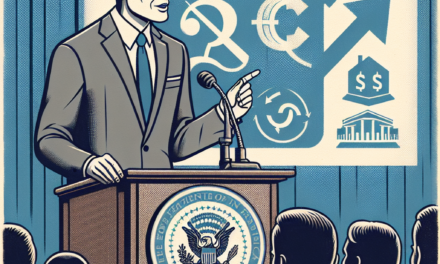“Unlocking Insights: The Schmid Unveiled Speech Transcript”
Introduction
“Speech Transcript: Schmid Unveiled” presents a comprehensive account of a pivotal address delivered by a key figure, Schmid, who reveals significant insights and developments within a specific context. This transcript captures the essence of Schmid’s message, highlighting critical themes, innovative ideas, and the implications of the information shared. It serves as an essential resource for understanding the nuances of the speech and the broader impact on the audience and relevant stakeholders.
Schmid Unveiled: Key Takeaways from the Speech Transcript
In the recent speech delivered by Schmid, several key themes emerged that warrant attention and reflection. The address, characterized by its clarity and depth, provided insights into the current state of affairs and the future direction of the organization. One of the most significant takeaways from the transcript is Schmid’s emphasis on innovation as a driving force behind progress. He articulated a vision where embracing new technologies and methodologies is not merely an option but a necessity for survival in an increasingly competitive landscape. This perspective underscores the importance of adaptability and forward-thinking in an era marked by rapid change.
Moreover, Schmid highlighted the critical role of collaboration in fostering innovation. He pointed out that no single entity can thrive in isolation; rather, success is often the result of collective effort. By encouraging partnerships across various sectors, Schmid illustrated how diverse perspectives can lead to more robust solutions. This call for collaboration resonates deeply in today’s interconnected world, where the challenges faced are often too complex for any one organization to tackle alone. As he elaborated on this theme, it became evident that fostering a culture of teamwork and shared goals is essential for achieving meaningful progress.
Transitioning from the theme of collaboration, Schmid also addressed the importance of sustainability in organizational practices. He articulated a vision where economic growth does not come at the expense of environmental stewardship. By integrating sustainable practices into the core operations, organizations can not only enhance their reputations but also contribute positively to the communities they serve. This commitment to sustainability reflects a growing awareness of the interconnectedness of economic, social, and environmental factors, and it positions organizations to thrive in a future that increasingly values responsible practices.
In addition to these themes, Schmid’s speech also touched upon the significance of inclusivity and diversity within organizations. He argued that a diverse workforce is not just a moral imperative but a strategic advantage. By embracing a variety of perspectives, organizations can foster creativity and innovation, ultimately leading to better decision-making and problem-solving. This emphasis on inclusivity aligns with broader societal trends that recognize the value of diverse voices in shaping effective policies and practices.
Furthermore, Schmid’s remarks on leadership were particularly noteworthy. He posited that effective leaders must be visionaries who inspire and empower their teams. This notion of leadership as a catalyst for change is crucial, as it highlights the responsibility leaders have in shaping organizational culture and driving progress. By cultivating an environment where individuals feel valued and motivated, leaders can unlock the full potential of their teams, leading to enhanced performance and satisfaction.
As the speech concluded, Schmid reiterated the importance of resilience in the face of challenges. He acknowledged that the path forward may be fraught with obstacles, yet he expressed confidence in the ability of organizations to navigate these difficulties through strategic planning and a commitment to core values. This message of resilience serves as a reminder that while the future may be uncertain, a steadfast commitment to innovation, collaboration, sustainability, inclusivity, and effective leadership can pave the way for success.
In summary, Schmid’s speech encapsulated a vision for the future that is both ambitious and attainable. By focusing on these key themes, he provided a roadmap for organizations seeking to thrive in a complex and ever-evolving landscape. The insights gleaned from this address not only inspire action but also encourage a collective commitment to building a better future for all stakeholders involved.
Analyzing the Impact of Schmid Unveiled on Industry Trends
The unveiling of Schmid has generated significant discourse within various sectors, prompting a thorough analysis of its potential impact on industry trends. As organizations strive to adapt to an ever-evolving landscape, the introduction of Schmid serves as a pivotal moment that could redefine operational paradigms. This innovation not only reflects the current trajectory of technological advancement but also sets the stage for future developments across multiple industries.
To begin with, Schmid’s integration of cutting-edge technology is poised to enhance efficiency and productivity. By leveraging advanced algorithms and data analytics, businesses can streamline their processes, thereby reducing operational costs and improving overall performance. This shift towards automation and data-driven decision-making is indicative of a broader trend where companies are increasingly prioritizing technological solutions to remain competitive. Consequently, industries that embrace Schmid’s capabilities may find themselves at the forefront of innovation, while those that resist may struggle to keep pace.
Moreover, the introduction of Schmid has implications for workforce dynamics. As automation becomes more prevalent, the nature of work is likely to evolve, necessitating a reevaluation of skill sets required in the labor market. This transition may lead to a demand for more specialized skills, particularly in areas such as data analysis, machine learning, and cybersecurity. Consequently, educational institutions and training programs will need to adapt their curricula to prepare the workforce for these emerging roles. In this context, Schmid not only influences current industry practices but also shapes the future landscape of employment.
In addition to its operational and workforce implications, Schmid’s unveiling also highlights the importance of sustainability in industry practices. As organizations increasingly recognize the need to address environmental concerns, Schmid’s emphasis on sustainable solutions aligns with this growing trend. By promoting eco-friendly practices and reducing waste through efficient resource management, Schmid encourages industries to adopt more responsible approaches. This alignment with sustainability not only enhances corporate social responsibility but also appeals to a consumer base that is increasingly conscious of environmental issues.
Furthermore, the impact of Schmid extends beyond individual organizations to influence broader market dynamics. As companies adopt Schmid’s innovations, competition is likely to intensify, prompting a wave of innovation across sectors. This competitive environment can lead to the emergence of new business models and partnerships, fostering collaboration among industry players. In this way, Schmid acts as a catalyst for change, encouraging organizations to rethink their strategies and explore new avenues for growth.
As we consider the implications of Schmid Unveiled, it is essential to recognize the interconnectedness of these trends. The advancements in technology, shifts in workforce requirements, emphasis on sustainability, and evolving market dynamics are all part of a larger narrative that defines the future of industry. By understanding these interrelationships, stakeholders can better navigate the complexities of this new landscape and position themselves for success.
In conclusion, the unveiling of Schmid represents a significant milestone that is likely to shape industry trends for years to come. Its influence on operational efficiency, workforce dynamics, sustainability, and market competition underscores the transformative potential of this innovation. As organizations continue to adapt to these changes, the lessons learned from Schmid will undoubtedly inform future strategies and practices, ultimately driving progress across various sectors.
The Role of Innovation in Schmid Unveiled: A Speech Breakdown
In the recent unveiling of Schmid, a significant emphasis was placed on the role of innovation in shaping the future of the organization. The speech delivered during this event highlighted how innovation serves as the cornerstone of Schmid’s mission and vision, driving not only the development of new products but also the enhancement of existing processes. As the speaker articulated, innovation is not merely a buzzword; it is a fundamental principle that permeates every aspect of the organization’s operations.
To begin with, the speaker underscored the importance of fostering a culture of creativity within Schmid. This culture encourages employees at all levels to contribute ideas and solutions, thereby creating an environment where innovation can thrive. By empowering individuals to think outside the box, Schmid positions itself to respond effectively to the ever-evolving demands of the market. The speaker noted that this approach not only enhances employee engagement but also leads to the generation of groundbreaking ideas that can propel the company forward.
Moreover, the speech elaborated on the strategic partnerships that Schmid has cultivated with various stakeholders, including academic institutions and technology firms. These collaborations are pivotal in driving innovation, as they allow for the exchange of knowledge and resources. The speaker emphasized that such partnerships enable Schmid to stay at the forefront of technological advancements, ensuring that the organization remains competitive in a rapidly changing landscape. By leveraging external expertise, Schmid can integrate cutting-edge technologies into its operations, thereby enhancing efficiency and productivity.
Transitioning to the practical implications of innovation, the speaker provided examples of recent projects that exemplify Schmid’s commitment to this principle. For instance, the introduction of a new product line that incorporates sustainable materials was highlighted as a testament to the organization’s dedication to environmental responsibility. This initiative not only meets consumer demand for eco-friendly products but also aligns with global sustainability goals. The speaker articulated that such innovations are essential for maintaining relevance in today’s market, where consumers are increasingly conscious of their purchasing decisions.
In addition to product innovation, the speech also addressed the significance of process innovation within Schmid. The speaker pointed out that optimizing internal processes can lead to significant cost savings and improved operational efficiency. By adopting advanced technologies such as automation and data analytics, Schmid is able to streamline its operations, reduce waste, and enhance overall performance. This focus on continuous improvement reflects the organization’s commitment to excellence and its desire to deliver the highest quality products and services to its customers.
Furthermore, the speaker acknowledged the challenges that come with pursuing innovation. It requires a willingness to take risks and embrace failure as a learning opportunity. Schmid recognizes that not every initiative will yield immediate success; however, the lessons learned from setbacks are invaluable in refining future strategies. This resilience is a hallmark of innovative organizations and is crucial for long-term sustainability.
In conclusion, the speech delivered during the Schmid Unveiled event effectively conveyed the integral role of innovation in the organization’s strategy. By fostering a culture of creativity, forming strategic partnerships, and focusing on both product and process innovation, Schmid is well-positioned to navigate the complexities of the modern marketplace. As the speaker aptly stated, innovation is not just a goal; it is a journey that Schmid is committed to undertaking, ensuring that it remains a leader in its field for years to come.
Lessons Learned from Schmid Unveiled: Insights for Future Leaders
In the realm of leadership, the recent event titled “Schmid Unveiled” has provided a wealth of insights that are invaluable for aspiring leaders. The discussions and presentations during this event highlighted several key lessons that can be applied to various leadership contexts. One of the most prominent themes that emerged was the importance of adaptability. In an ever-changing world, leaders must be prepared to pivot and adjust their strategies in response to new challenges and opportunities. This adaptability not only fosters resilience but also encourages innovation, as leaders who embrace change are more likely to inspire their teams to think creatively and explore new solutions.
Moreover, the event underscored the significance of effective communication. Throughout the presentations, it became evident that clear and transparent communication is essential for building trust within teams. Leaders who articulate their vision and expectations clearly are more likely to engage their team members and foster a collaborative environment. This is particularly crucial in times of uncertainty, where ambiguity can lead to confusion and disengagement. By prioritizing open lines of communication, leaders can ensure that their teams remain aligned and motivated, even in challenging circumstances.
In addition to adaptability and communication, the event also highlighted the value of emotional intelligence in leadership. Leaders who possess a high degree of emotional intelligence are better equipped to understand and manage their own emotions, as well as those of their team members. This understanding allows them to navigate interpersonal dynamics more effectively, fostering a supportive and inclusive workplace culture. As the discussions at Schmid Unveiled revealed, leaders who demonstrate empathy and actively listen to their team members are more likely to cultivate loyalty and commitment, ultimately driving better performance.
Furthermore, the importance of continuous learning was a recurring theme throughout the event. The rapidly evolving landscape of business and technology necessitates that leaders remain curious and open to new ideas. By committing to lifelong learning, leaders can stay ahead of industry trends and equip themselves with the knowledge needed to make informed decisions. This commitment not only enhances their own capabilities but also sets a positive example for their teams, encouraging a culture of growth and development.
Another critical lesson from Schmid Unveiled was the necessity of ethical leadership. In an age where corporate scandals and ethical breaches are increasingly scrutinized, leaders must prioritize integrity and accountability. The discussions emphasized that ethical leadership is not merely a moral obligation but also a strategic advantage. Organizations led by ethical leaders tend to enjoy higher levels of employee satisfaction and customer loyalty, as stakeholders are more likely to trust and support leaders who demonstrate a commitment to ethical practices.
Lastly, the event illuminated the power of collaboration. In today’s interconnected world, no leader can succeed in isolation. The ability to build partnerships and foster collaboration across diverse teams is essential for driving innovation and achieving organizational goals. Leaders who actively seek input from others and encourage teamwork are more likely to harness the collective intelligence of their teams, leading to more effective problem-solving and decision-making.
In conclusion, the lessons learned from Schmid Unveiled offer a roadmap for future leaders. By embracing adaptability, prioritizing communication, cultivating emotional intelligence, committing to continuous learning, practicing ethical leadership, and fostering collaboration, aspiring leaders can navigate the complexities of modern leadership with confidence and effectiveness. These insights not only enhance individual leadership capabilities but also contribute to the development of stronger, more resilient organizations.
Schmid Unveiled: A Deep Dive into the Speech’s Main Themes
In the recent speech delivered by Schmid, several key themes emerged that warrant a closer examination. The address, marked by its eloquence and depth, provided insights into the pressing issues of our time, while also offering a vision for the future. One of the most prominent themes was the importance of unity in addressing global challenges. Schmid emphasized that in an increasingly interconnected world, collaboration among nations, communities, and individuals is not merely beneficial but essential. This call for unity resonates deeply in a time when divisions seem to be widening, and it serves as a reminder that collective action can lead to meaningful change.
Transitioning from the theme of unity, Schmid also highlighted the critical role of innovation in driving progress. He articulated how technological advancements have the potential to solve some of the most pressing problems facing humanity today, from climate change to healthcare disparities. By fostering an environment that encourages creativity and embraces new ideas, societies can harness the power of innovation to create sustainable solutions. Schmid’s emphasis on innovation was not just a nod to the technological sector; rather, it was a broader call to rethink traditional approaches and to be open to transformative ideas that can reshape our future.
Moreover, Schmid addressed the significance of education as a cornerstone for empowerment and growth. He argued that access to quality education is fundamental in equipping individuals with the skills necessary to navigate an ever-evolving landscape. By investing in education, societies can cultivate a generation of thinkers and leaders who are prepared to tackle the challenges ahead. This theme of education dovetails with the earlier discussions on unity and innovation, as it is through education that individuals can learn to collaborate effectively and think critically about the innovations that will shape their world.
In addition to these themes, Schmid also touched upon the importance of sustainability. He underscored the urgent need for a paradigm shift in how we approach environmental issues. The speech articulated a vision where economic growth does not come at the expense of the planet, but rather, where sustainable practices are integrated into the very fabric of our economies. This perspective is increasingly relevant as the consequences of climate change become more pronounced, and it calls for a collective commitment to preserving our environment for future generations.
Furthermore, Schmid’s speech resonated with a sense of hope and resilience. He acknowledged the challenges that lie ahead but urged his audience to remain optimistic about the potential for positive change. This message of hope is particularly important in a world often characterized by uncertainty and fear. By fostering a mindset that embraces resilience, individuals and communities can better navigate adversity and emerge stronger.
In conclusion, Schmid’s speech was a profound exploration of themes that are not only timely but also timeless. The call for unity, the emphasis on innovation, the advocacy for education, the commitment to sustainability, and the message of hope all intertwine to create a comprehensive vision for the future. As we reflect on these themes, it becomes clear that they are interconnected and that addressing one often requires consideration of the others. Ultimately, Schmid’s address serves as a clarion call for collective action and a reminder that together, we can forge a path toward a brighter, more sustainable future.
The Audience Reaction to Schmid Unveiled: A Transcript Review
The unveiling of Schmid, a highly anticipated event, elicited a range of reactions from the audience, reflecting the diverse perspectives and expectations surrounding the presentation. As attendees settled into their seats, a palpable sense of excitement filled the air, underscoring the significance of the moment. The atmosphere was charged with anticipation, as many had followed the development of Schmid closely, eager to witness the culmination of extensive research and innovation.
As the presentation commenced, the audience was immediately drawn in by the speaker’s compelling introduction. The speaker articulated the vision behind Schmid, emphasizing its potential to revolutionize the field. This initial engagement set the tone for the rest of the event, as audience members leaned forward, eager to absorb every detail. The speaker’s passion was infectious, and it became evident that the audience was not merely passive observers; they were active participants in a shared journey of discovery.
Transitioning from the introduction to the core content, the speaker delved into the technical aspects of Schmid, providing a comprehensive overview of its features and functionalities. The audience listened intently, with many taking notes, indicating their desire to grasp the intricacies of the subject matter. As the presentation progressed, the speaker employed visual aids that enhanced understanding, allowing complex concepts to be conveyed with clarity. This strategic use of multimedia not only maintained engagement but also facilitated a deeper comprehension of Schmid’s capabilities.
However, as the presentation unfolded, it became apparent that not all reactions were uniformly positive. Some audience members expressed skepticism regarding the feasibility of implementing Schmid in real-world scenarios. This skepticism was particularly evident during the Q&A session, where questions arose about potential limitations and challenges. The speaker addressed these concerns with poise, providing thoughtful responses that acknowledged the complexities involved while reinforcing the transformative potential of Schmid. This exchange highlighted the dynamic nature of the audience’s engagement, as they navigated between enthusiasm and critical inquiry.
Moreover, the emotional responses within the audience were varied. While many were visibly excited, others appeared contemplative, reflecting on the implications of Schmid for their respective fields. This divergence in reactions underscored the multifaceted nature of innovation, where excitement can coexist with apprehension. As the presentation drew to a close, the speaker invited final thoughts, prompting a wave of applause that resonated throughout the venue. This collective response signified a recognition of the effort and dedication that had gone into the development of Schmid, even among those who remained cautious.
In conclusion, the audience’s reaction to Schmid Unveiled was a tapestry of emotions, ranging from enthusiasm to skepticism. The event served as a platform for dialogue, fostering an environment where ideas could be exchanged and challenged. As attendees departed, the discussions continued, reflecting a shared commitment to exploring the implications of Schmid further. This engagement not only highlighted the importance of innovation but also underscored the necessity of critical discourse in shaping the future of technology. Ultimately, the unveiling of Schmid was not merely an event; it was a catalyst for ongoing conversation and exploration, paving the way for future developments in the field.
Future Implications of Schmid Unveiled: What’s Next?
The unveiling of Schmid marks a significant milestone in the realm of technological advancement, prompting a myriad of discussions regarding its future implications. As we delve into the potential trajectories that Schmid may take, it becomes evident that its impact will resonate across various sectors, influencing not only industry practices but also societal norms and individual behaviors. The initial reception of Schmid has been overwhelmingly positive, with stakeholders expressing optimism about its capabilities and applications. However, this enthusiasm must be tempered with a critical examination of the challenges and opportunities that lie ahead.
One of the most immediate implications of Schmid is its potential to revolutionize existing workflows. By integrating advanced algorithms and machine learning capabilities, Schmid can streamline processes that have traditionally been labor-intensive. For instance, in sectors such as healthcare, Schmid could facilitate more accurate diagnostics and personalized treatment plans, thereby enhancing patient outcomes. As healthcare professionals begin to adopt this technology, it is crucial to consider the training and adaptation required to fully leverage its capabilities. This transition will necessitate a collaborative effort between technologists and practitioners to ensure that the implementation of Schmid is both effective and ethical.
Moreover, the introduction of Schmid raises important questions about data privacy and security. As the technology becomes more integrated into everyday operations, the volume of data generated will increase exponentially. Consequently, organizations must prioritize robust data governance frameworks to protect sensitive information. This challenge is compounded by the need for compliance with evolving regulations surrounding data protection. Therefore, as we look to the future, it is imperative that stakeholders engage in proactive discussions about ethical standards and best practices to safeguard user data while maximizing the benefits of Schmid.
In addition to operational enhancements, Schmid has the potential to reshape consumer experiences. With its ability to analyze vast amounts of data in real-time, businesses can gain deeper insights into consumer behavior, allowing for more tailored marketing strategies and improved customer service. This shift towards personalization could lead to heightened customer satisfaction and loyalty. However, it is essential to strike a balance between personalization and privacy, as consumers become increasingly aware of how their data is being utilized. As such, organizations must navigate this delicate landscape with transparency and integrity, fostering trust with their clientele.
Furthermore, the implications of Schmid extend beyond individual industries, influencing broader economic trends. As businesses adopt this technology, we may witness shifts in labor markets, with certain job roles becoming obsolete while new opportunities emerge. This evolution will require a concerted effort from educational institutions and policymakers to prepare the workforce for the demands of a technology-driven economy. By investing in reskilling and upskilling initiatives, society can mitigate the potential negative impacts of job displacement and ensure that individuals are equipped to thrive in an increasingly automated world.
In conclusion, the future implications of Schmid are vast and multifaceted, encompassing operational efficiencies, consumer experiences, data privacy, and economic shifts. As we stand on the precipice of this technological revolution, it is crucial for all stakeholders to engage in thoughtful dialogue and collaborative efforts. By addressing the challenges head-on and embracing the opportunities presented by Schmid, we can pave the way for a future that not only enhances productivity but also prioritizes ethical considerations and societal well-being. The journey ahead will undoubtedly be complex, yet it holds the promise of transformative change that can benefit individuals and communities alike.
Q&A
1. **What is the main topic of the speech “Schmid Unveiled”?**
– The speech focuses on the unveiling of Schmid’s new initiatives and innovations in technology.
2. **Who is the speaker of the speech?**
– The speaker is a prominent figure in the tech industry, likely a CEO or founder associated with Schmid.
3. **What are the key innovations discussed in the speech?**
– The speech highlights advancements in artificial intelligence, machine learning, and sustainable technology solutions.
4. **What is the intended impact of Schmid’s initiatives?**
– The initiatives aim to enhance efficiency, promote sustainability, and improve user experience across various sectors.
5. **How does the speaker address challenges in the industry?**
– The speaker acknowledges current challenges and outlines strategies to overcome them through innovation and collaboration.
6. **What future vision does the speaker present?**
– The speaker envisions a future where technology seamlessly integrates into daily life, driving progress and improving quality of life.
7. **What call to action is made at the end of the speech?**
– The speaker encourages collaboration among industry leaders, stakeholders, and the community to drive forward the initiatives discussed.
Conclusion
The speech transcript “Schmid Unveiled” presents a comprehensive overview of Schmid’s vision, achievements, and future goals, highlighting the importance of innovation and collaboration in driving progress. It emphasizes the need for transparency and accountability in leadership, while also addressing the challenges faced by the organization. Overall, the speech serves as a call to action for stakeholders to engage actively in the mission and work towards a shared vision for success.





